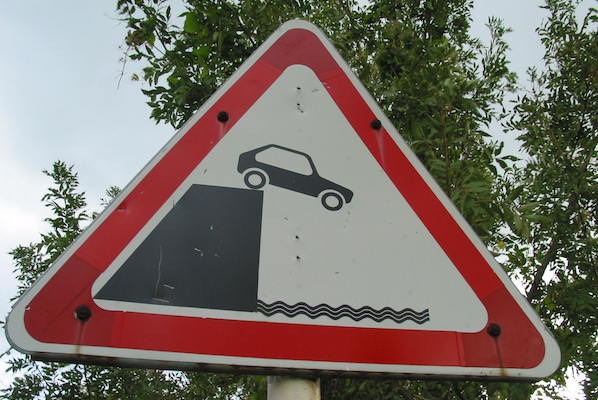Sustainability is one of those buzz-words. It is right up there with gender-balance and environment. That’s the problem.It means that everyone uses the word on every single proposal. Some projects should never be intended to be sustainable at all (like all disaster relief projects). Still, sustainable language is rammed into proposals.
The alternative is donor-funding suicide.

How do you know if something will actually last longer than your attention on this post? I like to use the crisis test.
Simply put, “If I get hit by a flaming meteor (or bus), does the project die with me?”
Stay with me, I have a story to tell.
How do we create sustainability?
For all the talk about how tough it is to start a sustainable project, I have found a lot of simple similarities to projects that last. It is not about partners, or time or inputs or beneficiaries or dollars involved.
What is consistent is the simple question of ownership. Whoever owns the project is responsible for it. Responsible people complete projects. So here is my advice:
Never own the project
By never I mean “Not. Ever.”, not even a little bit.
The person who owns the project is the person most invested in ‘making sure this happens’ You will lead it. You will use your charm to force things to happen. When people miss a meeting, you call around and check why and if they can make the next one. You will look for staff and volunteers. All of that looks suspiciously like ownership. Guess who is leading this thing? You got it. You own it.
When something goes wrong, people look to you. This may even feel great at first, but it will grow tiresome. When something breaks you fix it, when money is short you pay for it. When someone loses a phone, or needs a pen, or bus fare, you are responsible. If you start managing then you own it for a long time. So do not start.
So how is this possible?
I know one way it works. Steve works in Panama with the indigenous people. The people in the Comarca are economically poor. They live in basic homes, they cook over a 3 stone fire. Fuel is locally foraged sticks.
These rustic, open fires are romantic, as well as the source of pain in a home. The smoke causes eye and respiratory disease for the people nearby, children and women burn themselves when the wind picks up, or a kid isn’t careful. Still, a cooking fire is a necessity for life and most people don’t think much about the problem.
After all, we all have to eat.
Steve has an interesting take to the problem. He has taken an old technology, the ‘rocket stove’ (video below) and adapted it to be built in any community. The construction of his smokeless stove uses the chimney effect to burn smoke, which after all is nothing but unburnt fuel. This means that fires burn hotter and food cooks faster. People use less fuel which saves money and trees. The stove contains the fire which means less burn injuries. And finally, since the smoke is consumed, there is a lot less respiratory disease.
Huge wins. No downside.
Sounds great (and it is)
So Steve designed a project to bring those stoves into the community. Pause for a second and think about what you would do if you were in his shoes. If you were given the technology, how would you design a project?
Many development projects take the following steps:
- Develop the language/info/brochures/website to raise awareness of the problem and money for a smokeless stove campaign.
- Find your donors
- Build your team
- Find a beneficiary population
- Approach the community and ask if smoke in the home is a problem
- develop an awareness campaign to teach the harm
- Train a local trainer
- Find interested people and invite them to a seminar
- Provide incentives for people to show up (snacks, drinks, even a stipend)
- Hire some people to collect raw resources to put on a hands on demonstration
- Start a demonstration project
- Invite the community to an all-community meeting and answer questions
- Encourage people to adopt the technology
- Start workshops
- Test for impact
- Start in another community
- Do a follow-up survey
This is grossly simplified of course and not all development projects happen this way. But many are, and the bigger ones usually have a lot more steps.
Start this project and in a few years you may see a few thousand or even tens of thousands of stoves built. Peoples lives are improved. The approach works of course. But is it the best way?
Another way to change a community
… Steve’s approach is radically different:
- Steve visits communities where people still cook over a 3 stone fire.
- He rents a house in a community and moves in
- He starts to build a stove for his personal use
- People watch in curiosity
- He invites people over for tea
- He makes tea on the stove
- They ask Steve questions like “where is the smoke?” and he answers them all
- The next question usually is, “How can we get one of these?”
- Steve tells them, “come by tomorrow and I will show you how to make it”
- He shows them, they learn
- Steve leaves the community
- People build it for themselves
- People start small businesses and build the stoves for others
So which approach is sustainable.
Which works?
Both CAN be sustainable of course, but I sure like Steve’s plan. He never has to encourage people to share, it happens naturally in his model. He passes “the bus test”, If he was run over, the project continues. There is something powerful about distributing ownership from the beginning of a project.
If you want to see the stove in action (moments after we built it in Panama) you should check out this short, raw video.
Remember this.
If you own the problem and the solution you are in charge.
Fight the impulse!
Expect that you are working with capable people. If they don’t want your solution, maybe they don’t really need it, or that you haven’t convinced anyone that your solution matters. In either case it is not in your best interest to keep going the way you are.
Try something new, who knows, it just might turn out to be sustainable!
What do you like about Steve’s approach?
Mark Crocker

